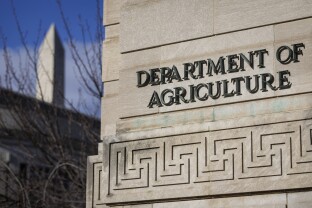The Department of Agriculture notified regional Supplemental Nutritional Assistance Program directors on Friday that federal funds for the program — which provides food benefits to low-income families — will run out after October if the government shutdown continues.
The notice was first reported by Axios. NOTUS reviewed a copy of the email sent to the state agencies.
“If the current lapse in appropriations continues, there will be insufficient funds to pay full November SNAP benefits for approximately 42 million individuals across the Nation,” states the letter.
The memo acknowledged that states have questions about the situation and said the USDA “has begun the process of fact finding and information gathering to be prepared in case a contingency plan must be implemented.”
The government shutdown, which began at the start of October, has no end in sight. The funding lapse has left states struggling to plan for program funding like the Special Supplemental Nutrition Program for Women, Infants, and Children.
The memo, which was issued by the USDA’s Food and Nutrition Service department, gives the guidance of “[holding] their November issuance files” and “[delaying] transmission to State EBT vendors until further notice. This includes on-going SNAP benefits and daily files.”
The USDA did not immediately respond to a request for comment.
One state health official told NOTUS that their state is looking at funding the benefits themselves but added that there is concern states won’t be reimbursed. There is also confusion around the White House’s recent commitment to use tariff funding to keep WIC funded.
“We’ve received no guidance from the feds as to how that would work or if it is even happening,” the state health official told NOTUS.
The official explained that even without the guidance, states will have to start notifying those with benefits as soon as next week about the lack of funds for the month of November.
SNAP is a U.S. federal aid program managed by the USDA that helps low-income individuals and families buy food through an electronic benefit transfer card. Roughly 42 million Americans are served by this program.
This site is protected by reCAPTCHA, and the Google Privacy Policy and Terms of Service apply. By continuing on NOTUS, you agree to its Terms of Use and Privacy Policy.
Sign in
Log into your free account with your email. Don’t have one?
This site is protected by reCAPTCHA, and the Google Privacy Policy and Terms of Service apply. By continuing on NOTUS, you agree to its Terms of Use and Privacy Policy.
Check your email for a one-time code.
We sent a 4-digit code to . Enter the pin to confirm your account.
New code will be available in 1:00
Let’s try this again.
We encountered an error with the passcode sent to . Please reenter your email.
This site is protected by reCAPTCHA, and the Google Privacy Policy and Terms of Service apply. By continuing on NOTUS, you agree to its Terms of Use and Privacy Policy.


